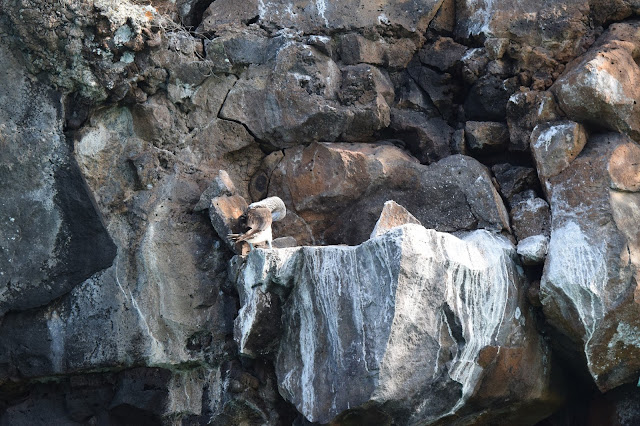The day today started with a trip up to the top of another extinct volcano. The mountain top wasn't as big as the one yesterday; however, once at the top, one could see pretty much the entire island of Santa Cruz including the town I am staying, coastlines, and boarders of the national park. I was also able to see a giant sinkhole about in the middle of the island that was to be my next stop. Nearly 97-98% of the Galapagos is national park land which is quite impressive.
In order to see not just one sinkhole but a few, I had to enter the park's gate. While driving to the park, I noticed a few giant tortoises crossing signs which I thought was unique; probably will never see those any place other than the Galapagos.
A small hike took me to a giant sinkhole. Sinkholes are created when the ceilings of lava tubes/tunnels under the ground give way, creating sometimes small or in this case large holes. The guide also pointed out how the black raspberry (an invasive species) has taken over the land. This was mentioned to me before a few days ago. Also, cedar trees that grew tall around the hole (crater only for volcanoes) and elsewhere on the island where introduced and causing problems with the acidity levels in the soil. We went on to find another sinkhole that was created in the same way; however, one could notice that it was really two sinkholes that had merged together. Along the sides of the holes, you could see lava tube openings.
After the trip to the sinkholes, passing a banana farm, and dodging a herd of cows being prodded by a farm hand down a dirt road, I ventured into a park that advertised giant land tortoises and lava tube explorations. Once in the park, I hiked along a field to find several giant dome-shaped tortoise eating and taking mud bathes. It's interesting in that the animals are free to roam anywhere which meant the farmers or property owners must allow enough room under their fences to allow tortoises to pass; I caught one doing just that.
After viewing the tortoises I went down into a lava tube that was created by a flowing stream of hot lava surrounded by cooler lava millions of years ago. You could easily see the markings and traces of ancient lava flows while exploring the tube. It's a reminder that the Earth once was, still is, and always will be... on the move.
The day ended with a boat trip around the bay where pelicans were diving for fish only a few feet away and blue footed boobies were nesting only a few yards away along cliff sides. My guide talked about the history and culture of the island as we went along the side of the bay and harbor. We ended up going ashore and hiking a couple miles inland to see mangrove trees where egrets from the highland would come to roost every night. The mangroves also provided excellent sea turtle nurseries. As I walked along a small beach, areas were roped off to give privacy and care to areas where iguanas had laid their eggs. I ended the hike near a long fissure where some local people were swimming and then on top of a cliff overlooking the bay and harbor that I just patrolled around in earlier.
So the day was quite full and adventurous as usually... can't believe that tomorrow is my last full day here.
360 of Santa Cruz on top of a small extincted volcano
One of a few sinkholes... the vegetation at the bottom is mainly blackberries (invasive and non-usable for human consumption - (no or poor tastes unlike the ones you know of))
Bananas hanging down from a banana tree
Male Dome Tortoise
Male Dome Tortoise having had a mud bath
A day at the spa with friends
Nice and cozy
Male tortoise walking about very slowly
(picture provided by http://www.enchantedlearning.com)
Anatomy of a tortoise shell. I wanted to provide this to you to help explain that the age of tortoise can be somewhat determined by rings within the hexagonal plates on the upper shell or carapace. As the plates grow, the rings go away making it harder to determine the age of the animal.
Dream come true to visit and see giant land tortoises in the Galapagos... just another day with a tourist for the tortoise
Land dome-shelled tortoise on the move
Lamps illuminating a path through a lava tube
Blue Footed Boobie along the cliff side during my excursion around the harbor
Iguana Nest











Walking among those giant land tortoises on the farms in the highlands of Santa Cruz is always thrilling.
ReplyDelete